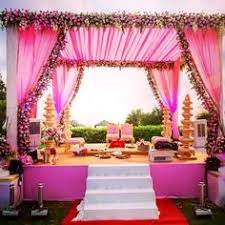
Mandap
The Mandap in Hindu weddings serves as the central part of the wedding decorations and acts as the altar in marriage ceremonies. Wedding mandaps are considered the sanctum sanctorum space where all the significant marriage rituals are performed. This is indeed a special place and the center of focus as the most important people at the wedding will be seated here for everyone to witness the nuptials.
The concept of mandap is very ancient as they believed that any sacred ritual has to be performed within the four walls. However, this is not the case in this millennial world as Indian wedding mandaps have grown increasingly fashionable and trendy and are done in marriage halls, beaches, open grounds, and more (all thanks to rising in the popularity of destination weddings). But, of course, these modern mandaps are based on Vedic beliefs that meet a modern twist.
Well, be it a beach or otherwise, wedding mandaps are undeniably the center of the decorations in marriages.
So, let’s find out more about the beautiful Indian wedding mandaps.
Importance Of Mandap
After the Jai mala or Varmala session, the bride and the groom take their seats at the mandap to commence the wedding ceremony. The mandap space is specially allocated for the bride, groom, their immediate family members, and the priest conducting the marriage ceremony. The parents of the couple sit beside them watching and in some taking part in the customs and rituals.
The Agni Kund (the sacred ceremonial fire) is centered between the couple and is used during the ceremony by the priest while reciting holy mantras from Vedas.
All the rituals during the mandap ceremony are done in front of the sacred fire Vedic hymns recited by the priest. The main wedding rituals performed at the mandap include Kanyadaan, Saat Phere or Saptapadi, Sindoor or Maang Bharai, and Mangalsutra.
The Significance Behind The Mandap Design?
Every Hindu ritual has some deep meaning attached to it according to the Vedic traditions. The mandap is a very important element of a Hindu wedding, even its design and decor are meaningful.
The four pillars of the Indian wedding mandaps symbolizes the four stages of life as per Vedas - Brahmacharya (student), Grihastha (householder), Vanaprastha (retired) and Sannyasa (renunciate). Indeed, like a grand stepping into the next stage of life, the groom steps out of his bachelor life to enter the life of a householder. Other interpretations say that the pillars represent the parents of the couple and even the walls of the home where the newlywed couple will start their new life.
Besides, the sacred fire or Agni that is lit at the center of the mandap is the Saakshi or witness to the marriage. As per Vedas, Agni stands for purity and spirituality.
How Is The Mandap Decorated?
The Mandap (referred to in North India) or Manavarai (referred to in South India) is a temporary four structure with a canopy that forms the sacred space for traditional Hindu weddings.
Traditionally, the pillars are made using wood, bamboo, sugarcane, or young banana stems. the top of the mandap is covered in a red or gold canopy. Stacks of brightly decorated pots are placed near each pillar that is called ‘Chori’, and these pots symbolize the four elements of nature - Earth, Water, Fire and Air, and the 5th element - Space - is represented by the canopy on the top. The entire stage is decorated using garlands of marigold, banana leaves, pots filled with water, statues of gods, and the use of silk and gold hues. Religious offerings comprising herbs, ghee, raw rice, among others are placed near the sacred fire for the Priest and couple to offer to the fire throughout the ceremony.
Wedding mandaps are usually created on a raised platform so that guests can see the wedding ceremony from their seats.
Indian wedding mandaps nowadays have become quite fancy in design and decoration. Couples prefer intricate and stunning mandaps and rope in event planners and designers to create unique as well as themed designs using items like chandeliers, fabric, lights, and various other materials.
Every object and ritual of a Hindu wedding has some of the other highly significant meanings. That is great! An Indian wedding mandap is something that binds all the wedding rituals together. And to witness the mandap ceremony would be a surreal experience.
